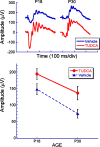Bile acids in treatment of ocular disease
- PMID: 20046852
- PMCID: PMC2798994
- DOI: 10.1007/s12177-009-9030-x
Bile acids in treatment of ocular disease
Abstract
Bear bile has been included in Asian pharmacopeias for thousands of years in treatment of several diseases, ranging from sore throat to hemorrhoids. The hydrophilic bile acids tauroursodeoxycholic acid (TUDCA) and ursodeoxycholic acid (UDCA) are the major bile acids of bear bile. Both of these are available as synthetic formulations and are approved by the health administrations of several countries for treatment of cirrhosis and gallstones. This review briefly covers the use of bear bile in Traditional Chinese Medicine, bile acid physiology, approved use of UDCA and TUDCA in Western medicine, and recent research exploring their neuroprotective properties, including in models of ocular disease.
Figures









Similar articles
-
The bile acid TUDCA and neurodegenerative disorders: An overview.Life Sci. 2021 May 1;272:119252. doi: 10.1016/j.lfs.2021.119252. Epub 2021 Feb 23. Life Sci. 2021. PMID: 33636170 Review.
-
A validated surrogate analyte UPLC-MS/MS assay for quantitation of TUDCA, TCDCA, UDCA and CDCA in rat plasma: Application in a pharmacokinetic study of cultured bear bile powder.Biomed Chromatogr. 2020 Jul;34(7):e4835. doi: 10.1002/bmc.4835. Epub 2020 Apr 7. Biomed Chromatogr. 2020. PMID: 32198899
-
Bile Acids Reduce Prion Conversion, Reduce Neuronal Loss, and Prolong Male Survival in Models of Prion Disease.J Virol. 2015 Aug;89(15):7660-72. doi: 10.1128/JVI.01165-15. J Virol. 2015. PMID: 25972546 Free PMC article.
-
Comparative Analysis of Urso- and Tauroursodeoxycholic Acid Neuroprotective Effects on Retinal Degeneration Models.Pharmaceuticals (Basel). 2022 Mar 9;15(3):334. doi: 10.3390/ph15030334. Pharmaceuticals (Basel). 2022. PMID: 35337132 Free PMC article.
-
The Unexpected Uses of Urso- and Tauroursodeoxycholic Acid in the Treatment of Non-liver Diseases.Glob Adv Health Med. 2014 May;3(3):58-69. doi: 10.7453/gahmj.2014.017. Glob Adv Health Med. 2014. PMID: 24891994 Free PMC article. Review.
Cited by
-
Current and future therapeutic strategies for the treatment of retinal neurodegenerative diseases.Neural Regen Res. 2022 Jan;17(1):103-104. doi: 10.4103/1673-5374.314305. Neural Regen Res. 2022. PMID: 34100441 Free PMC article. No abstract available.
-
Controlled delivery of tauroursodeoxycholic acid from biodegradable microspheres slows retinal degeneration and vision loss in P23H rats.PLoS One. 2017 May 25;12(5):e0177998. doi: 10.1371/journal.pone.0177998. eCollection 2017. PLoS One. 2017. PMID: 28542454 Free PMC article.
-
TUDCA modulates drug bioavailability to regulate resistance to acute ER stress in Saccharomyces cerevisiae.Mol Biol Cell. 2025 Feb 1;36(2):ar13. doi: 10.1091/mbc.E24-04-0147. Epub 2024 Dec 11. Mol Biol Cell. 2025. PMID: 39661468 Free PMC article.
-
Unveiling the gut-eye axis: how microbial metabolites influence ocular health and disease.Front Med (Lausanne). 2024 May 10;11:1377186. doi: 10.3389/fmed.2024.1377186. eCollection 2024. Front Med (Lausanne). 2024. PMID: 38799150 Free PMC article. Review.
-
Effects of huangqi and bear bile on recurrent parotitis in children: a new clinical approach.J Zhejiang Univ Sci B. 2013 Mar;14(3):253-8. doi: 10.1631/jzus.B1200072. J Zhejiang Univ Sci B. 2013. PMID: 23463769 Free PMC article. Clinical Trial.
References
-
- Cidian Z. Dictionary of traditional Chinese medicine. Shanghai: Shanghai Science and Technology Press; 2004.
-
- Lee Y-J. The use of bear bile as medicine versus tonic. In: Williamson DF and Phipps MJ, editors. Proceedings of the Third International Symposium on the Trade in Bear Parts. Seoul: TRAFFIC East Asia; 1999. p. 122–126
-
- Gabriel GG.A bitter medicine: the use of bear bile in China. In: Williamson DF and Phipps MJ, editors. Proceedings of the Third International Symposium on the Trade in Bear Parts. Seoul: TRAFFIC East Asia; 1999. p. 116–120.
-
- Hanson DG. Poaching: Oriental demand for undgam and paws decimates California bears. Audubon. 1983;85:127–128.
Grants and funding
LinkOut - more resources
Full Text Sources
Other Literature Sources
